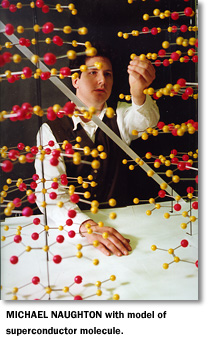 New experiments conducted by UB physicists have demonstrated the
strongest evidence yet for this strange and extremely promising
phenomenon, called reentrant superconductivity.
New experiments conducted by UB physicists have demonstrated the
strongest evidence yet for this strange and extremely promising
phenomenon, called reentrant superconductivity. 
But according to a 1986 theory initially considered outlandish, superconductivity should reappear in a material if it is oriented precisely in line with a very high magnetic field.
 New experiments conducted by UB physicists have demonstrated the
strongest evidence yet for this strange and extremely promising
phenomenon, called reentrant superconductivity.
New experiments conducted by UB physicists have demonstrated the
strongest evidence yet for this strange and extremely promising
phenomenon, called reentrant superconductivity.
"If this phenomenon exists, it means the complete opposite of everything that is known about superconductivity and magnetism," said Michael Naughton, associate professor of physics and chemistry at UB and lead investigator.
The results may constitute the best demonstration so far of an extremely rare type of interaction between electrons in a superconductor. This type of interaction, called p-wave spin, has only been seen once before in nature, and its discoverers were awarded the Nobel Prize in Physics.
It has never been seen in a superconductor.
While the UB findings are fundamental, the existence of reentrant superconductivity could have dramatic practical applications, ranging from greatly improved energy storage to far more precise magnetic resonance imaging.
The research is described in a paper published in Physical Review Letters (Vol. 78) authored by Naughton and In Jae Lee, a doctoral candidate in physics at UB and co-authored by researchers at Princeton University.
The researchers caution that they do not yet have solid evidence of reentrant superconductivity.
However, according to Naughton and Lee, results with their material, a low-temperature, molecular superconductor-(TMTSF)2PF6-demonstrate several key indicators that strongly support the existence of such a phenomenon.
"We can see this interesting behavior because we worked so hard to orient the crystal in the magnetic field, according to the 1986 theory," said Naughton. "If you move it, this anomalous effect is gone."
Typically, Naughton explained, magnetic fields destroy superconductivity because the energy they generate perturbs the close interaction between pairs of electrons that is a prerequisite for superconductivity.
The most common way that a magnetic field destroys superconductivity is by disturbing the orbital effect, where the electrons in a pair orbit each other, acquiring more and more energy from the magnetic field. Once this energy becomes greater than that which unites the two electrons, the electron pairs break apart and
superconductivity is suppressed.
The other way magnetic fields can destroy superconductivity is when two electrons have what is called opposite spin; this is when in addition to the two electrons orbiting one another, they also are spinning like tops but in opposite directions, called s-wave spin. When the magnetic field is turned on, one electron gains energy while the other loses it.
"If that difference is bigger than the amount of energy holding the electrons together, then they fly apart and superconductivity is gone," explained Naughton.
But when electrons exhibit the extremely rare phenomenon known as p-wave spin, where both are spinning in the same direction, the magnetic field cannot destroy superconductivity by the spin-effect. This is because while the field may change the electrons' total energy, it doesn't change the difference in energy between them.
Naughton said that the existence of p-wave spin has been proven only once, in superfluid helium; the discovery was so profound that the scientists who made it were awarded the 1996 Nobel Prize in Physics.
But if p-wave spin is truly what the UB researchers have detected, this would be the first time that p-wave spin has been found in a superconductor. "Our results may constitute the strongest evidence yet for p-wave superconductivity, short of actually proving its existence," Naughton said.
For expanded coverage, go to http://www.buffalo.edu/news/Latest/NaughtonMagneticField.html